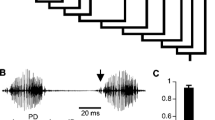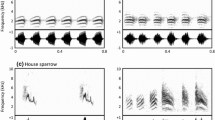Abstract
Female phonotaxis of Tettigonia viridissima and T. caudata was investigated on a walking compensator to determine the temporal parameters of the male song used for song recognition, and to compare them with the previously described pulse rate filtering of T. cantans. The T. cantans song is continuous with a ≈30-Hz pulse rate. The T. caudata song has a higher pulse rate (≈40 Hz) and duty cycle than T. cantans and a distinct verse structure. The T. viridissima song is continuous with a double-pulse pattern. While the pulse rate is essential for song recognition in T. cantans, neither pulse rate not verse structure were essential for song recognition in T. caudata: females responded to signals above a minimum duty cycle. T. viridissima females did not require the double-pulse structure, but a single long pulse, equivalent to the duration of the double pulses and interval between them, was effective. Song attractiveness was limited by a minimum duration of the merged double pulse, and by minimum and maximum duration of the interval between them. Pulse rate recognition had little if any importance in either of the species investigated. Thus, the three congeners use different mechanisms for temporal song recognition.
Similar content being viewed by others
Author information
Authors and Affiliations
Additional information
Accepted: 18 June 1998
Rights and permissions
About this article
Cite this article
Schul, J. Song recognition by temporal cues in a group of closely related bushcricket species (genus Tettigonia). J Comp Physiol A 183, 401–410 (1998). https://doi.org/10.1007/s003590050266
Issue Date:
DOI: https://doi.org/10.1007/s003590050266




